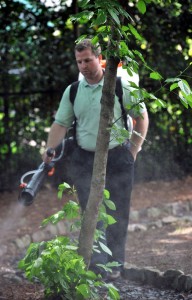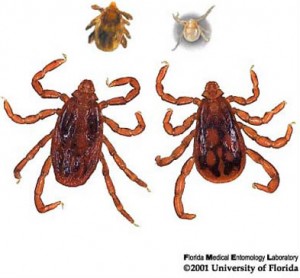READY TO GET STARTED?
REQUEST A FREE ESTIMATE
Fill out the form below or call (888) 466-7849 for a free, no-obligation estimate.
Brief description:
The stink bug gets its name from its ability to release an odor when they are disturbed or crushed. Stink bugs have a triangular or shield shape.
Habits:
Different species:
Threats:
Prevention:
Other pests to look out for:

Northwest Exterminating representative, Courtesy of AJC
Need tips on how to keep mosquitoes away?
These are just a few tips on keeping mosquitoes away. Mosquitoes are known carriers of diseases like West Nile virus, encephalitis, and heartworms in dogs. Make sure that you are protecting yourself and your loved ones. For more information, visit our blog or call Northwest Exterminating at 888.466.7849.
Why Do Mosquitoes Love Me So Much?
Each warm season brings questions from homeowners and pet owners regarding ticks. We worry about our furry family members and ourselves if we plan on spending time outdoors, especially in or around wooded areas.
The brown dog tick is one species of tick that should be cause for concern, especially for those who have dogs. Although they feed on a wide variety of mammals, dogs are their preferred host. These ticks are unique in that they can complete an entire life cycle indoors. They feed on the host for about a week before dropping off and laying their eggs…up to 5,000 eggs!! After she’s done laying her eggs, she dies. The full life cycle of a brown dog tick lasts just over two months and generally are long living creatures.

Tick Life Cycle – Source
A brown dog tick infestation can develop in high quantities and very quickly. Oftentimes, ticks go unnoticed on dogs until the ticks are spotted throughout the home.
To protect your home and your dog from brown tick infestation, here are some brown dog tick control tips:
For more detailed information on the brown dog tick, visit http://www.entnemdept.ufl.edu/creatures/urban/medical/brown_dog_tick.htm.
 Director of Pest Services at Northwest Exterminating, Adam Vannest, was recently featured in Pest Management Professional magazine. Adam answered some Q and A’s regarding fleas and ticks and also gave some Do’s and Don’ts for when dealing with these pesky pests.
Director of Pest Services at Northwest Exterminating, Adam Vannest, was recently featured in Pest Management Professional magazine. Adam answered some Q and A’s regarding fleas and ticks and also gave some Do’s and Don’ts for when dealing with these pesky pests.
Read below to get the full story:
Adam Vannest, director of pest services for the Atlanta area’s Northwest Exterminating, has faced plenty of hard-to-solve flea and tick problems. He recently shared tales of some memorable infestations — and his team’s solutions — with Pest Management Professional.
Q: What’s the largest flea and tick infestation you’ve faced, and how did you conquer the pests?
Vannest: One of the largest was in a rural subdivision that backed up into a large wooded area. The customer reported dealing with an intense flea problem and said she’d also noticed multiple ticks on the family dog. Seeing ticks on her children was this customer’s threshold point.
While inspecting the outside we noticed a lot of the areas around the home were overgrown. There were tall weeds and grass up against the house and woodpiles around the exterior. We started looking at the ticks’ harborage sites to figure out why they would be attracted to the location. It was a three-story house on a crawlspace, and once inside we noticed the crawlspace door was already open. There were also other entry points because it wasn’t sealed up very well. We definitely found fleas in the crawlspace. The main floor and upstairs also had fleas.
We explained to the customer that we wanted to eliminate harborage areas around the outside by cutting down weeds and trimming the grass around the foundation. We also educated the homeowner about the crawlspace and how many entry points were visible to stray animals and rodents. We had an exclusion team come out and seal up those areas so that we could treat it with a residual product and an insect growth regulator (IGR).
Next, we explained to the customer that to get our product were it needs to be we’d have to remove everything from the floor for cleaning and vacuuming. We also instructed them to take the dog to the vet for treatment. After that, we applied a broadcast treatment to the floor surfaces and throughout the house.
We had to treat the lawn for ticks as well.
Q:What’s your hardest-to-find flea and tick story. How did you solve the problem?
Vannest: It took place at a ranch house on a crawlspace. When we inspected we noticed that the family pets were pest free. This told us we were dealing with a population in the home that had been carried inside by other means.
Sometimes people forget all of the other things that can be responsible for bringing fleas into a home. Some of the hardest flea problems to solve are ones where a rodent population carries them inside.
We inspected the rest of the house and found pockets of flea activity but no defined area. However, when we got to the attic level we found a roof rat population bringing in fleas from outside, so we applied residual products and treatments there to eliminate the rodent problem. When we placed monitors to determine where flea hot spots existed we found a few more harborage sites that had been egg-laying areas. We targeted those areas and eliminated the problem.
Adam Vannest’s Dos & Don’ts
Do
■ Train technicians to always think outside the box. Every flea situation and every tick situation can be different.
■ Know your products and which ones are best for a particular infestation. Read labels and test the products.
■ Use monitoring to help find hot spots.
Don’t
■ Don’t assume the customer is doing the prep work.
■ Don’t assume every situation is going to be the same.
■ Don’t stop educating your technicians. Give them ongoing training.
You can visit Pest Management Professional magazine by going to www.mypmp.net
Note: We will link directly to the article as soon as it is available online!
Bed bugs are small parasitic insects that feed on the blood of humans and animals, typically while they sleep. Usually, they live within 8 feet of where people sleep but are known to travel up to 100 feet in one night! This is because they can go many months without having to have a meal. When they take a bite, they will leave a small bite mark that, at worst, can cause a serious allergic reaction, but are otherwise not known to be a source of disease.
Unlike their name suggests, bed bugs can be found in houses, apartments, hotels, trains, and even cruise ships. At one time, it was thought that these insects were only an issue in developing countries, but recently they have rapidly spread throughout North America and parts of Europe. They travel through the seams and folds of luggage, overnight bags, clothing, bedding and furniture. Despite what conventional wisdom suggests, the presence of bed bugs does not have to do with lack of cleanliness. Bed bugs go where food can be found.
Bed bug infestation will most likely be spotted after they have already gotten to you. If you see inexplicable bite marks on your body after you wake up, you might want to investigate further. Looking around your sleeping area, you may discover bed bug exoskeletons, a sweet musty order, rusty-colored blood spots and of course, actual bed bugs in the folds of mattresses and sheets.
The treatment and prevention of bed bugs is where Northwest Exterminating comes in. We offer services to rid your home of bed bugs should an infestation occur. If you find that you have encountered these unwelcome bed guests, be sure to contact your nearest service center!
Melissa Brown
[email protected]
Source: